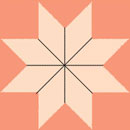|
LeMoyne Star
 LeMoyne Star LeMoyne Star
 LeMoyne Star
Ohio Farmer
1894
This venerable design was first published in 1894, as Star, in Ohio Farmer. The block was named for two brothers who founded New Orleans in 1718, according to Yvonne Khin's Collector's Dictionary of Quilt Names and Patterns. English-speaking settlers renamed it Lemon Star.
For more LeMoyne variations, click here: 
|
|
Hunter's Star
|
 Hunter's Star
Hall & Kretsinger Hunter's Star
Hall & Kretsinger
1935
Hunter's Star is the oldest and the hardest to make. Each corner of each quarter-block includes an inset diamond. To stitch a diamond into a whole piece of cloth takes significant skill, even made by hand.
The block was first published in 1935 (in Hall's and Kretsinger's The Romance of the Patchwork Quilt in America) but is doubtless much older.
The difference between the two blocks is clearest when you compare their quarter blocks. Hunter Star is on the left, Hunter's Star is in the center, and Gretchen, the next block on this page, is on the right.
Hunter's, Hunter, or Gretchen? Check a corner! |
 |
 |
 |
Hunter's Star has
inset points |
Hunter Star has
a pieced bar |
Gretchen turns the
pieces around |
|

Hunter Star
   
   
   
   
Hunter Star
 Hunter Star
Aunt Martha Hunter Star
Aunt Martha
1960

Indian Arrowhead
Hunter Star came along in 1960, in an Aunt Martha booklet.
If you look at the seams, you'll see that each quarter-block is made up of a three-part bar attached to a triangle.
Every corner in the block is made of two seams sewn together.
Hunter Star is well suited to strip-piecing, which is a quick way to cut out blocks using a rotary cutter, a tool much like the rolling blade used to cut a pizza.
We've posted diagrams for you to use to make either block. Just click on the purple icon.
|
Gretchen
 Gretchen Gretchen
Kansas City Star
1932
It's very similar to Hunter Star and Hunter's Star. All three create a lattice effect across a quilt top, but Gretchen has a windmill shape in the center instead of a star. |
|
|
Blazing Star
Harvest Star
 Blazing Star
LAC Blazing Star
LAC
 Blazing Star Blazing Star
 Blazing Star Blazing Star
An old, popular three-ring star adds triangles to the Virginia Star to form a thorny octagon. Blazing Star was the Ladies Art Company's name for the two-color version (1897, #372). The name Harvest Star only came along in 1981.
Sewing on the Bias
Diamond stars are among the most beloved quilt designs. They are also among the most difficult to make well.
At least two sides of each diamond-star piece are cut on the bias
(diagonal to the threads in the fabric).
Biased edges tend to stretch as they're sewn, and if they do, the seam won't lie flat.
Such imperfections multiply with each ring of diamonds, and they can
turn the quilt top into a sheet of ripples. Fortunately, expert quilting can help mask the effect.
|
|
|
|
 Le Moyne & more
***
Le Moyne & more
***
 LeMoyne Star
LeMoyne Star Hunter's Star
Hunter's Star Hunter
Hunter Gretchen
Gretchen Virginia Star
Virginia Star Blazing Star
Blazing Star National Star
National Star  Blazing Star
Blazing Star Northum-berland Star
Northum-berland Star








 Gretchen
Gretchen Blazing Star
Blazing Star Blazing Star
Blazing Star  National Star
National Star Blazing Star
Blazing Star
 Northumberland Star
Northumberland Star